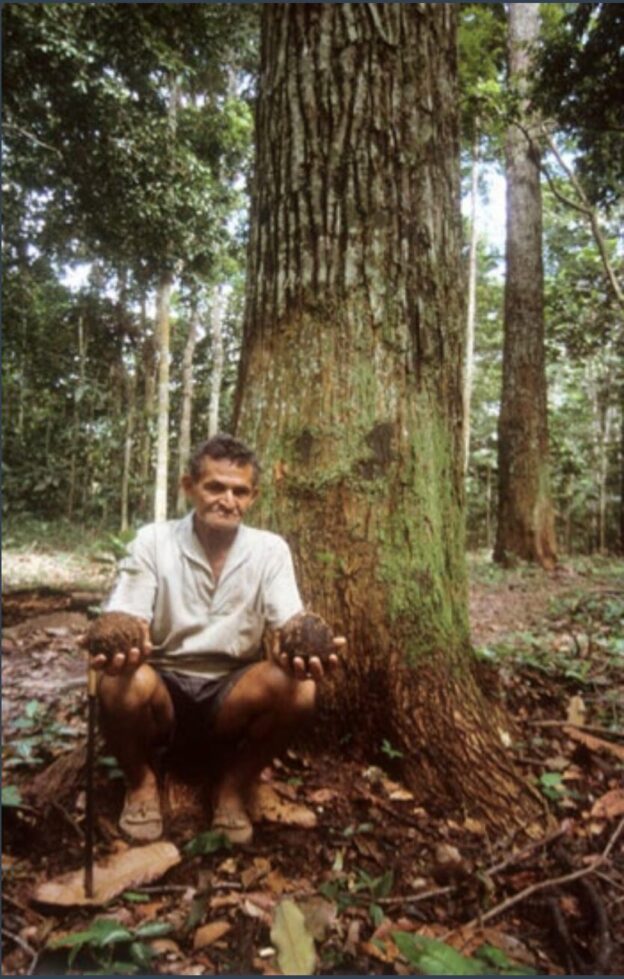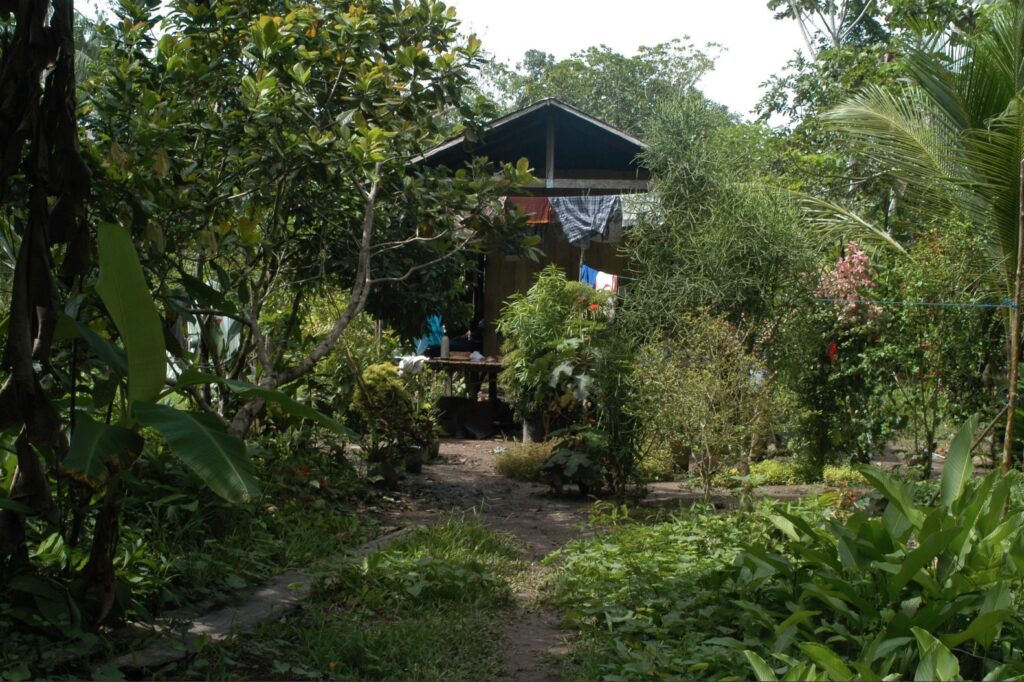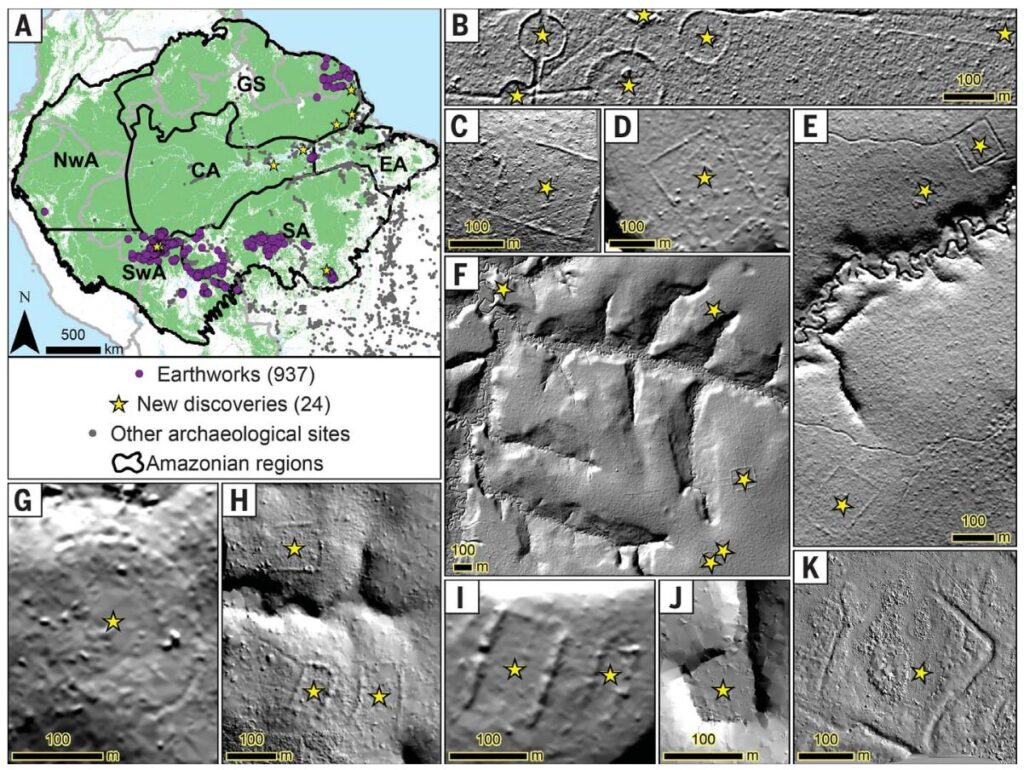Amazonian Forest Farming: Records of the Past Inform Management of Today
This blog post is the third in a five-part series written by Yale School of the Environment students enrolled in a graduate seminar that accompanied the spring 2025 Yale Forest Forum, “A History of People, Forests, and Forestry.” The webinar series and seminar were cohosted by the Yale Forest Forum and the Forest History Society.
Each student was asked to select a presentation and write an essay reflecting on what they learned. Sophia Roberts chose Eduardo Neves’s “The Role of Indigenous Peoples in Creating the Amazonian Rainforest.” You can watch the presentation video on Vimeo.
***
The Amazon forest basin boasts an incredible diversity of plants and animals, including more than 16,000 species of trees alone. Spanning eight different countries, at 5.5 million square kilometers, it is the world’s largest tropical rainforest, a critical biodiversity hotspot and carbon sink that helps regulate the planet’s climate and oxygen supply. As it turns out, the composition of the Amazon’s vast forests that we know today is thanks in large part to people. In fact, less than two percent of all tree species there account for half of all trees that make up the forest, the most common of which have been important food and medicine sources for forest-dependent communities over the past 4,000 years (ter Steege et al. 2013, Levis et al. 2017). The way people have been managing these forests for millennia challenges the notion that forest basins like the Amazon, with their low population density, have not undergone much development. Rather, people are an integral part of maintaining long-term forest health, and this connection to the landscape is a key piece of the solution to the global climate and biodiversity crises we face today.
INDIGENOUS FOREST MANAGEMENT
Native Amazonian societies, through generations of careful stewardship, developed the forest into a pantry and apothecary located in their own backyards. One researcher shedding light on indigenous forest management in the Amazon is Eduardo Neves, Professor of Archaeology at the University of São Paulo, Brazil. Neves has found that these forest communities removed unwanted plants while nurturing useful ones, fundamentally changing the distribution of plants and wildlife in the region (Neves et al. 2021). Cacao, Brazil Nuts, acai, papayas, cashews—we can thank ancient Amazonian societies for preserving and selecting these and other cultivars to produce higher yields of these modern delicacies. Almost 70 percent of cultivated plants in the Amazon are trees or shrubs, allowing for these gardens of the past to grow in a structure that resembles an untouched forest (Clement et al. 2010). Despite this mixing of species, domesticated plants are five times more likely than non-domesticated plants to be dominant, and the abundance of these useful species is higher around known archaeological sites (Levis et al. 2017), offering yet more evidence of purposeful cultivation.
(Right) Image by E. Neves of a house with a typical wild-growing yard in Codajás, Central Amazȏnia.


(Left) One of the largest tree species in the Amazon, the Brazil nut tree nut can reach heights of 50 meters (160 feet) and live for 500 years. A Brazil nut can weigh as much as 2 kg (4.4 lbs.), and is known for its nutritional value. Brazil nut oil is used in cosmetics and cooking. The wood from the tree is valued for its strength, and is used in carpentry, flooring and heavy construction. However, it's illegal to log this species in Brazil without prior authorization from the federal government.
SOIL AND MOUNDS AS EVIDENCE OF THESE SOCIETIES
While the archeological record of the Amazon is represented by the tree species that we see today, the evidence does not stop there. Soil found in the region, known as Amazonian Dark Earth (ADE) soil (Terras Pretas de Índio in Portuguese), is a clear remnant of human settlement (Maezumi et al. 2018). Tropical soils generally have poor nutrient availability because of frequent rain and weathering, but ADE contains mollusk shells, charcoal, and a variety of nutrients that support agriculture on a scale to feed large groups of people—people that lived in these ancient cities and depended on this fertile land for their horticultural practices.
Until recently, the dense tree canopy made it difficult to find these cities. Beyond in situ observations, remote sensing now plays a prominent role in identifying historic sites. In a project led by Vinicius Peripato at Brazil’s National Institute for Space Research (Instituto Nacional de Pesquisas Espaciais), more than 20 settlements in the Amazon have been found with Light Detection and Ranging (LiDAR) technology over the past decade, and they estimate that at least 10,000 more ancient earthworks are buried beneath the trees (Peripato et al. 2023). LiDAR is a remote sensing technology that generates structural information at unprecedented detail. These sensors send pulses of light down to the ground and calculate ground structure based on the amount of time it takes for the light to travel back to the sensor. Crucially, LiDAR can reach through a forest’s canopy to the ground and even penetrate through water. This is a game-changing advancement for studying places like the Amazon, where ground-based formations were previously hidden by dense tree canopy. Thanks to this state-of-the-art technology, researchers now have archeological evidence of mounds in the Amazon basin that offer a glimpse into long-standing communities as seen in the figure below depicting newly discovered earthworks. For example, researchers discovered an ancient plaza town in the Upper Xingu Basin, a region still stewarded by the native Xingu peoples (Peripato et al. 2023). These records are important for historical understanding, but they can also play a role in modern debates about indigenous land rights, supporting proof of occupancy.

INDIGENOUS LEADERSHIP
Indigenous people not only helped shape the forest as we know it; they also continue to protect it from being lost to the modern industrial-extractive economy. The Xingu River Basin covers 280,000 sq. km. of forest and is stewarded by more than two dozen indigenous groups (Schwartzman et al. 2013). Although this land has been protected and sustainably managed for millennia, it—along with the rest of the Amazon basin—now faces threats of deforestation led by external demand for the land. Without the indigenous societies that protect these spaces, the Amazonian ecosystem that we depend on may become entirely degraded. This is contrary to the traditional conservation strategy of removing people from protected areas, and there is a growing understanding that people are a necessary part of the ecosystem and play a critical role in long-term conservation.
CONCLUSIONS
Management decisions made over centuries past in the Amazon continue to yield environmental influence globally. Brazil Nut trees, for example, are some of the largest trees in the neotropics; essential for their carbon-sequestration abilities, they thrive in abundance due to cultivation by previous generations. Normally, the swaths of thick green canopy and expansive rivers across the Amazon basin control rainfall patterns based on evapotranspiration and outflow of moisture to urban spaces far beyond the forest edge. Despite the vital role that the Amazon basin plays in regulating the climate across borders, the lifeforce of the region, the Amazon River, dropped to record-low water levels in recent years, in large part due to drought and climate change. The drought revealed carvings in the river banks from past societies, possibly from as far back as 2000 years ago. Coincidentally, this year’s Conference of Parties (COP30), hosted by the United Nations Framework Convention on Climate Change, will be held in Belém, Brazil—the gateway to the Amazon. This is a chance for the world to witness the very real effects that ecosystems like the Amazon are facing from climate change and, perhaps, to learn from the stewards of these forests about the art and science of maintaining a reciprocal relationship with the planet. The robust evidence of ancient Amazon communities and their relationship with forest plants should be considered as we determine next steps in the conservation of these forests. Maybe this evidence of historic communities literally resurfacing can serve as a reminder of what we must do to ensure that these highly diverse ecosystems remain.
References
Clement, C. R., et al. “Origin and Domestication of Native Amazonian Crops.” Diversity 2, no. 1 (2010): 72–106. https://doi.org/10.3390/d2010072.
Levis, C., et al. “Persistent Effects of Pre-Columbian Pant Domestication on Amazonian Forest Composition.” Science 355 (2017): 925–31. DOI:10.1126/science.aal0157.
Maezumi, S. Y., et al. “The Legacy of 4,500 Years of Polyculture Agroforestry in the Eastern Amazon.” Nature Plants 4 (2018): 540–47. https://doi.org/10.1038/s41477-018-0205-y.
Neves, E., et al. “Peoples of the Amazon before European Colonization.” United Nations Sustainable Development Solutions Network. n.d. https://www.academia.edu/50106390/Peoples_of_the_Amazon_before_European_Colonization.
Peripato, V., et al. “More than 10,000 Pre-Columbian Earthworks are Still Hidden Throughout Amazonia.” Science 382 (2023): 103–109. DOI:10.1126/science.ade2541.
Schwartzman, S., et al. “The Natural and Social History of the Indigenous Lands and Protected Areas Corridor of the Xingu River Basin.” Philosophical Transactions of the Royal Society B: Biological Sciences 368, no. 1619 (2013). http://doi.org/10.1098/rstb.2012.0164.
Smith, B. D. “Documenting Domesticated Plants In The Archaeological Record.” In Documenting Domestication, edited by M. A. Zeder, D. Bradley, E. Emshwiller, and B. D. Smith. University of California Press, 2006.
ter Steege, H, et al. “Hyperdominance in the Amazonian Tree Flora.” Science 342 (2013): DOI:10.1126/science.1243092.

